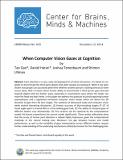| dc.contributor.author | Gao, Tao | |
| dc.contributor.author | Harari, Daniel | |
| dc.contributor.author | Tenenbaum, Joshua | |
| dc.contributor.author | Ullman, Shimon | |
| dc.date.accessioned | 2015-12-11T20:48:15Z | |
| dc.date.available | 2015-12-11T20:48:15Z | |
| dc.date.issued | 2014-12-12 | |
| dc.identifier.uri | http://hdl.handle.net/1721.1/100190 | |
| dc.description.abstract | Joint attention is a core, early-developing form of social interaction. It is based on our ability to discriminate the third party objects that other people are looking at. While it has been shown that people can accurately determine whether another person is looking directly at them versus away, little is known about human ability to discriminate a third person gaze directed towards objects that are further away, especially in unconstraint cases where the looker can move her head and eyes freely. In this paper we address this question by jointly exploring human psychophysics and a cognitively motivated computer vision model, which can detect the 3D direction of gaze from 2D face images. The synthesis of behavioral study and computer vision yields several interesting discoveries. (1) Human accuracy of discriminating targets 8{\deg}-10{\deg} of visual angle apart is around 40% in a free looking gaze task; (2) The ability to interpret gaze of different lookers vary dramatically; (3) This variance can be captured by the computational model; (4) Human outperforms the current model significantly. These results collectively show that the acuity of human joint attention is indeed highly impressive, given the computational challenge of the natural looking task. Moreover, the gap between human and model performance, as well as the variability of gaze interpretation across different lookers, require further understanding of the underlying mechanisms utilized by humans for this challenging task. | en_US |
| dc.description.sponsorship | This work was supported by the Center for Brains, Minds and Machines (CBMM), funded by NSF STC award CCF-1231216. | en_US |
| dc.language.iso | en_US | en_US |
| dc.publisher | Center for Brains, Minds and Machines (CBMM), arXiv | en_US |
| dc.relation.ispartofseries | CBMM Memo Series;025 | |
| dc.rights | Attribution-NonCommercial 3.0 United States | * |
| dc.rights.uri | http://creativecommons.org/licenses/by-nc/3.0/us/ | * |
| dc.subject | Computer vision | en_US |
| dc.subject | Gaze | en_US |
| dc.subject | Social Interaction | en_US |
| dc.subject | Artificial Intelligence | en_US |
| dc.title | When Computer Vision Gazes at Cognition | en_US |
| dc.type | Technical Report | en_US |
| dc.type | Working Paper | en_US |
| dc.type | Other | en_US |
| dc.identifier.citation | arXiv:1412.2672 | en_US |
